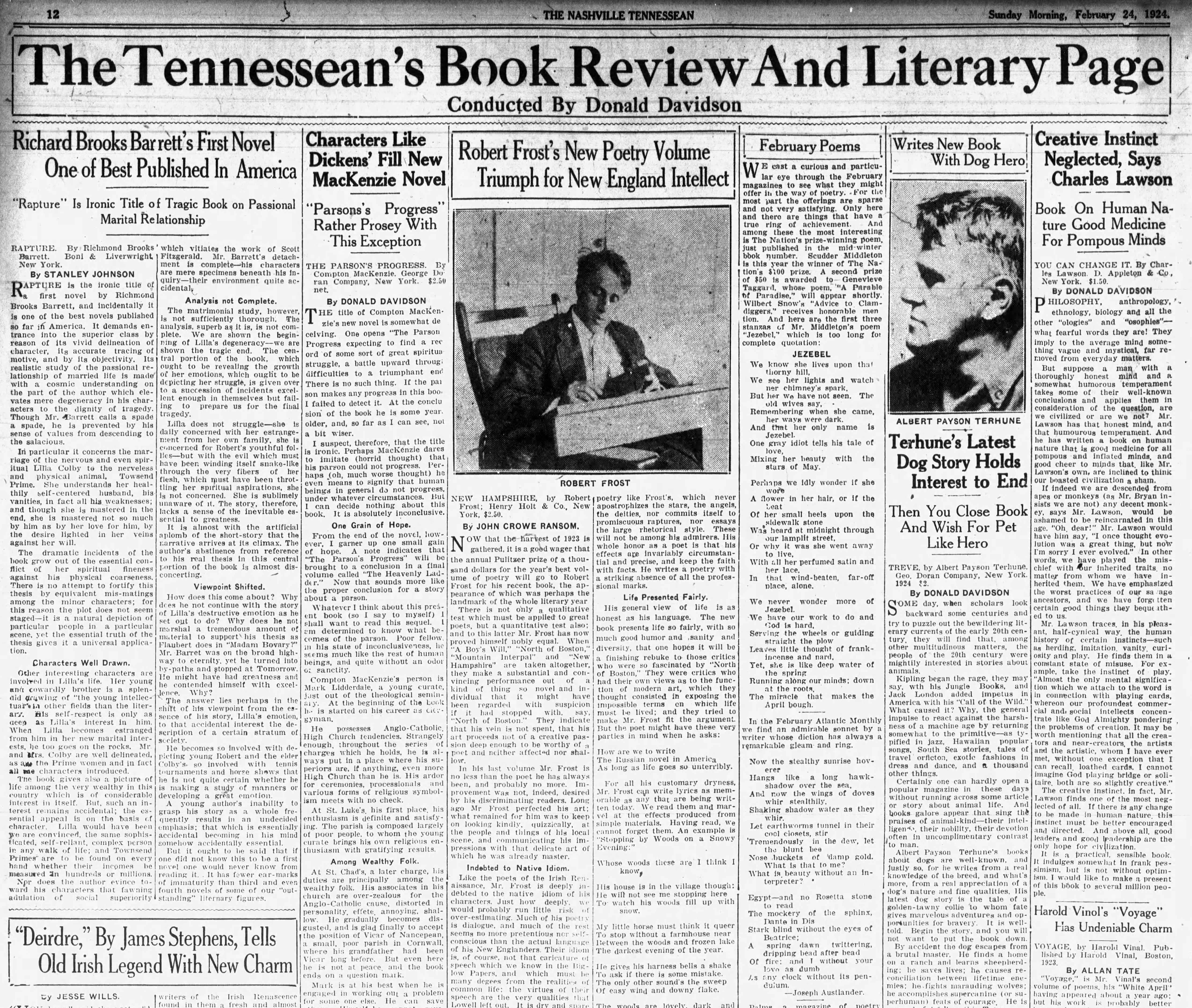“I can claim no ultimate wisdom in the matter. I can only say that I reviewed books in Tennessee for seven years, and during the same period persuaded a great many people to do likewise. The book page that I edited had a very modest beginning in 1924 in the Nashville Tennessean.” – Donald Davidson
1924 unfurled. The weather, customary of January in Nashville, -2° one day, 60o the next. William Jennings Bryan was about town all jacked up on Mountain Dew coming at evolution like a spider monkey. John H. Nye, managing editor of the Nashville Tennessean, asked Donald Davidson if he would consider editing a book page. On Sunday morning, February 4, 1924, The Tennessean’s Book and Literary Page by Donald Davidson debuted on the forty-fourth page featuring reviews by Davidson, Stanley Johnson, John Crowe Ransom, Allen Tate, and Jesse Wills.
Davidson penned a weekly column, “The Spyglass,” later renamed “The Critic’s Almanac” for the page. His goal was to make up for the South’s lack of a reputed literary magazine. With a dash of Scots and a pinch of Irish, he crafted a book page of distinction, given the constraints of his era, all while preserving a Southern perspective.
The page’s success teetered, tightly entwined with the fate of Colonel Luke Lea, owner and publisher of the Tennessean, Commercial Appeal of Memphis, and the Knoxville Journal (which eventually syndicated Davidson’s column). During its zenith, “The Spyglass/Critic’s Almanac” reached readers across five states: Tennessee, Mississippi, Kentucky, Arkansas, and Alabama.
Despite its humble circulation, Davidson’s book page offered a genuine literary culture to tens of thousands of everyday folks—enriching the literary landscape across the South. In sharing his thoughts with the people of his community, Davidson discovered a deeper kinship with his Southern identity. While his writings traversed the literature of several locales, the genesis of his Agrarian sensibility could be glimpsed in his comments on Southern culture shared in his hometown paper.
During his near seven-year stint editing the Tennessean’s book page, Davidson used nearly 400 reviewers, ranging from historians like Stanley F. Horn and Robert Selph Henry to notable critics like Allen Tate and John Crowe Ransom to amateurs like Vanderbilt undergraduates—Andrew Lytle, Cleanth Brooks, and Robert Penn Warren. These reviewers worked merely for free books and the satisfaction of seeing their opinions published.
In the initial years, few contributors outside of Middle Tennessee were encouraged, except for permanent members of Nashville’s intellectual community like Andrew Lytle. Writing from a family farm in Guntersville, Alabama, Lytle wrote: “I aim to review about four significant books a month, with a particular focus on plays. I’d prefer to cover more volumes of poetry than novels, unless the demand for them is too high. And if you harbor even a smidgen of affection for me, please don’t let another antique book escape to some eager hand…”
William Alexander Percy declined Davidson’s invitation to write for the page in a letter: “I was delighted to see your name on The Literary Page of the Commercial Appeal. Judging from the result you have already accomplished, you are going to make this the outstanding page of literary criticism in Southern journalism … As for writing occasional reviews, let me confess to you that I have little respect for my own abilities in the role of reviewer.”
From Fugitive to Agrarian
“As The Fugitive magazine neared its end, some Fugitives, including John Crowe Ransom, Allen Tate, Robert Penn Warren, and myself, transitioned into our Agrarian phase around 1925 to 1930, turning the Book Page into a vibrant canvas of our collective ideas, hopes, and endeavors.” – Donald Davidson
Often celebrated as the South’s finest, the Tennessean‘s literary page was connected with the Southern literary renascence. The pivotal shift from poetry to social criticism, notably within the Fugitive and Agrarian movements, unfolded between The Fugitive’s last issue in December 1925 and I’ll Take My Stand in 1930–a shift chronicled on the Tennessean’s page.
Davidson said the book page was a shared platform, reflecting “our general group concern about the arts, and the position of the South.” It was understood to be a publication available to the group and its backers. Thus, it served as an experimental space for Davidson, John Crowe Ransom, Allen Tate, Robert Penn Warren, Andrew Lytle, Frank Owsley, Lyle Lanier, H. C. Nixon, and Henry B. Kline—nine of the twelve Southerners who later published I’ll Take My Stand.
The End For Now
“During the seven years I must have reviewed at least a thousand books myself—a total of words, passed into the oblivion of newsprint, which would equal the content of several good-sized volumes. I have handled and given to others probably ten thousand books; written how many thousands of letters I know not … accumulated a library on the principle of pure opportunity—I am thankful that it includes a number of excellent cookbooks, which will solace my declining years more than first editions.” – Donald Davidson
The abrupt end of the book page, amidst the Great Depression, was anticipated yet poignant for Davidson. His November 26, 1930, letter to publishers and reviewers expresses regret for the page’s discontinuation and his departure from the Tennessean on November 30. Bidding heartfelt farewell, Davidson lamented the loss of this literary link between readers and current books.
Under the Green Lamp
On the eve of the publication of I’ll Take My Stand, Richmond Croom Beatty arrived at Vanderbilt, where he trod the halls with Walter Lynwood Fleming, Allen Tate, John Crowe Ransom, Donald Davidson, George Pullen Jackson, Walter Clyde Curry, Edwin Mims, and John Donald Wade.
Under John Donald Wade’s guidance, Beatty undertook graduate studies, mingling with fellow students—Edd Winfield Parks, Egbert Sydnor Ownbey, and John Tyree Fain.
Beatty chose Virginia’s William Byrd II for his thesis. Though he became a noted professor and author, throat cancer silenced his lectures. He found a new calling as the literary editor for the Nashville Tennessean’s book page and authored the column “Under the Green Lamp” from 1956 until his death in 1961.
In the wake of ‘Dick’ Beatty’s death, Floy W. Beatty, his wife, carried on his work. From 1961-1976, she presided over the book page and column, where some 15,000 books crossed her desk. Mrs. Beatty died in 1992.
Under the Beatty’s editorship, readers were treated to reviews by Richard Weaver, Walter Sullivan, M.E. Bradford, H.C. Nixon, Floyd C. Watkins, M. Thomas Inge, Jesse Hill Ford, and George Core.
Sources
Donald Davidson, “Criticism Outside New York”
Donald Davidson, The Spyglass, Views and Reviews, 1924-1930: Selected and Edited by John Tyree Fain. Vanderbilt University Press, 1963.
Mark Royden Winchell, Where No Flag Flies: Donald Davidson and The Southern Resistance. University Of Missouri Press, 2000.
Notes
- “Even in the twentieth century, some of the best writing of the South appeared first on the book pages of Southern newspapers, such as those of Frances Newman in The Atlanta Constitution, Donald Davidson in The Nashville Tennessean, John H. McGinnis in The Dallas News, Lyle Saxon and John McClure in The New Orleans Times-Picayune, Nell Battle Lewis in The Raleigh News and Observer, and Edwin Bjorkman in The Asheville Times. I use the past tense, for unfortunately, the Southern book page would seem to have passed its heyday, and most of the book pages I have mentioned are now in other hands.” – Jay B. Hubbell, Culture in the South, 1934
- Davidson’s page “was the most distinguished single Sunday literary page in the United States in its time.” – Kenneth M. England, Mississippi Quarterly, 1964
- Ralph Morrissey wrote the “Under the Green Lamp” column and edited the Tennessean book page before Richmond Croom Beatty. In the 40s, Harry Goldgar edited the “Random Reader” book page.







Fantastic article, Chase.
Coincidentally, on my drive to work this morning, I was listening to a 2012 Abbeville Institute Summer School lecture titled “Donald Davidson and the Meaning of Agrarianism” by Alan Harrelson. I recently purchased a copy of the book, “I’ll Take Mt Stand.” I look forward to reading more of your articles on the Southern Agrarians. Thanks!
Thank you for the well-researched article. I learned more about a subject on which I thought I was well-informed.
Excellent article. I’ve just finished going over I’ll Take My Stand for a piece I’m working on, and this was like icing on the cake. It makes so many connections that are thought provoking. Thanks for sharing this bounty of information.